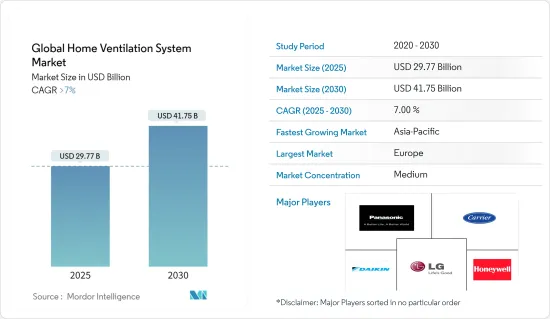PUBLISHER: Mordor Intelligence | PRODUCT CODE: 1631633

PUBLISHER: Mordor Intelligence | PRODUCT CODE: 1631633
Global Home Ventilation System - Market Share Analysis, Industry Trends & Statistics, Growth Forecasts (2025 - 2030)
The Global Home Ventilation System Market size is estimated at USD 29.77 billion in 2025, and is expected to reach USD 41.75 billion by 2030, at a CAGR of greater than 7% during the forecast period (2025-2030).

Home ventilation systems provide residents with a safe and comfortable living environment. These systems regulate airflow in the home to prevent pollutants like smoke, carbon dioxide, and volatile organic compounds from accumulating. When outdoor pollutant levels are high or indoor temperatures rise during the summer months, homes should have multiple ventilation fans installed throughout the interior to expel dangerous gases from within. The growing demand for open-plan homes, rising construction activity in emerging economies such as India and China, and rising awareness about energy efficiency are some of the key factors driving market growth. Furthermore, growing health concerns about indoor air quality have increased the demand for efficient ventilation systems in residential buildings.
The post-COVID-19 scenario has brought increased awareness about the importance of home ventilation. With more people spending time indoors, there has been a growing demand for proper ventilation systems to improve indoor air quality. Companies in the home ventilation market have been focusing on developing innovative solutions that enhance air circulation and filtration. This includes technologies like HEPA filters, smart ventilation systems, and energy-efficient options.
Home Ventilation System Market Trends
Innovations in Cost-Effective Energy Recovery Ventilation (ERV)
The HVAC industry's technological development is focused on cost-cutting initiatives and improving existing technology. Latent heat storage with higher storage density and smaller temperature changes is becoming more popular. The potential use of Phase Change Material (PCM) in HVAC solutions for thermal storage and temperature maintenance applications, as well as innovations in Next Generation Ventilation (NeGeV) to optimize system performance and meet ventilation and cooling demands for commercial and industrial sectors, are among the factors driving the market growth. Furthermore, significant developments and innovations in mechanical ventilation systems are expected to match current price levels and significantly reduce operating costs while offering 50-90% lower energy consumption and a lower carbon footprint. All of the aforementioned factors are expected to support market growth and provide market participants with lucrative growth opportunities.
Home Renovation Industry is Propelling the Sales of Home Ventilation System Market
Homeowners' shifting preferences for energy-efficient and luxurious living spaces are significantly contributing to the industry's growth in ventilation systems. Rapid urbanization, combined with government initiatives to provide incentives and tax credits for green building construction, has fueled market growth for home ventilation systems. Furthermore, the popularity of e-commerce and the availability of technologically advanced system upgrades will drive global home ventilation system activity.
Home Ventilation System Industry Overview
The home ventilation system market is fragmented with many players. The report includes an overview of home ventilation companies operating across global. We wish to present a detailed profiling of a few major companies which cover product offerings, regulations governing them, their headquarters, and financial performance. Currently, some of the major players dominating the market are Panasonic, Carrier, Honeywell, Daikin Industries, and LG.
Additional Benefits:
- The market estimate (ME) sheet in Excel format
- 3 months of analyst support
TABLE OF CONTENTS
1 INTRODUCTION
- 1.1 Study Assumptions and Market Definition
- 1.2 Scope of the Study
2 RESEARCH METHODOLOGY
3 EXECUTIVE SUMMARY
4 MARKET DYNAMICS
- 4.1 Market Overview
- 4.2 Market Drivers
- 4.2.1 Increasing Awareness about Indoor Air Quality
- 4.2.2 Rising Trend of Smart Homes
- 4.3 Market Restraints
- 4.3.1 Lack of Proper Regulations and Standards in Some Regions
- 4.4 Market Opportunities
- 4.4.1 Growing Demand for Energy-Efficient Solutions
- 4.5 Value Chain/Supply Chain Analyisis
- 4.6 Porter's Five Forces Analysis
- 4.6.1 Bargaining Power of Buyers/Consumers
- 4.6.2 Bargaining Power of Suppliers
- 4.6.3 Threat of New Entrants
- 4.6.4 Threat of Substitute Products
- 4.6.5 Intensity of Competitive Rivalry
- 4.7 Insights on Government Regulations on Ventilation System Market
- 4.8 Insights on Technological Trends and Consumer Preferences
- 4.9 Impact of COVID-19 on the Market
5 MARKET SEGMENTATION
- 5.1 By Product Type
- 5.1.1 Exhaust Ventilation System
- 5.1.2 Supply Ventilation System
- 5.1.3 Balanced Ventilation System
- 5.1.4 Energy Recovery System
- 5.2 By Application
- 5.2.1 New Decoration
- 5.2.2 Renovation
- 5.3 By Geography
- 5.3.1 North America
- 5.3.2 South America
- 5.3.3 Europe
- 5.3.4 Asia-Pacific
- 5.3.5 Middle East & Africa
6 COMPETITIVE LANDSCAPE
- 6.1 Market Competition Overview (Market Concentration And M&A Deals)
- 6.2 Company Profiles
- 6.2.1 Panasonic
- 6.2.2 Carrier
- 6.2.3 Johnson Controls
- 6.2.4 Honeywell
- 6.2.5 Daikin Industries
- 6.2.6 LG
- 6.2.7 Samsung
- 6.2.8 Lennox
- 6.2.9 Unovent
- 6.2.10 Atlantic*
7 MARKET FUTURE TRENDS
8 DISCLAIMER AND ABOUT US




